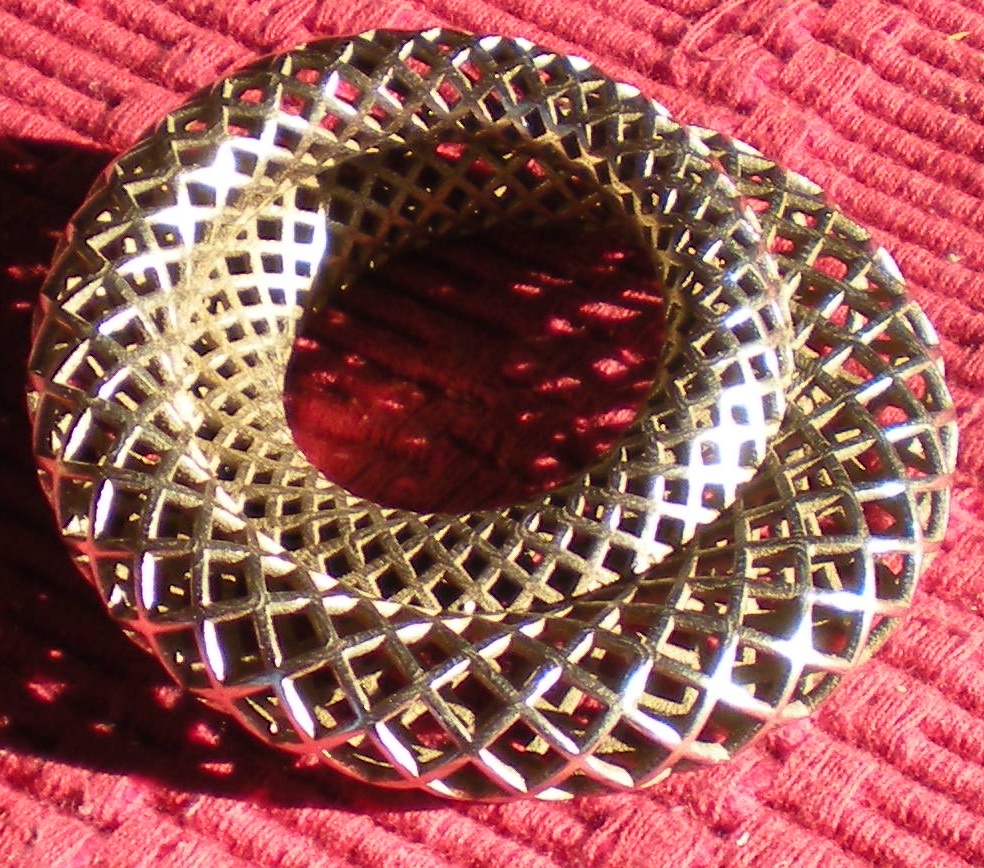
I’ve had other designs made in steel but not this one. (The sintering leaves the steel highly porous, so liquid bronze is brought in by capillary action to fill it; the result is about three parts steel to two parts bronze – if I understand right. Hence the color.) (Later: I was mistaken: the steel powder is not sintered but glued; I guess the bronze burns away the glue.)
While it was on its way to me, I thought of some improvements.
One subtle practical change
The model is defined by its surface, which consists of thousands of triangles. All of my designs so far are made of bent rods; I place the vertices of the triangles along a helix. Previously I’ve used an odd number of vertices in two turns.
For metal, Shapeways wants a flat area 1mm square (I guess to attach sprues for the bronze), and also they want the rod 1.5mm thick rather than 1.0mm as for plastic; so I did this:
The flat top and bottom are more appropriate anyway, since the model represents a surface. But oops, the parallelograms are split on their long diagonal; this means that on the outside of each curve the inevitable concavities are longer and deeper than necessary. I’ve corrected that for my next designs.
One radical change for my sense of mathematical purity
I prefer to use conformal mappings wherever possible: these are geometric transformations that preserve local angles. When the figure-eight is swept around the circle, the inner part moves less than the outer, and I wanted the inner lobe to shrink in the same proportion. The obvious solution was the exponential function in the complex plane. (Every function that has a well-defined derivative is conformal, except where that derivative is zero.)
Obvious and wrong. The mapping within this plane is conformal, but I want scaling to be proportional to distance from the axis of rotation, not from the center point. I began to suspect there’s no way to do it right.
But then I think of Clifford torus and I get idea, haha!
A Clifford torus is a surface in four dimensions whose points’ coordinates (w,x,y,z) fit two equations: w² + x² = a² and y² + z² = b², for some constants a,b. (Some restrict the definition to the special case a = b = 1/√2.) You can add the two equations, w² + x² + y² + z² = a² + b²; this implies that a Clifford torus lies on the three-dimensional hypersurface of a hypersphere, a space known as S³.
A torus in Euclidean 3-space (E³) has positive (spherelike) curvature on its outside and negative (saddle-like) curvature on its inside. A Clifford torus, in contrast, has the same curvature everywhere. To an inhabitant of S³, it looks like an endless cylinder whose axis is a great circle (the straightest possible arc in that space).
A similar uniformity applies to any figure in S³ swept along a great circle orthogonal to its own plane. I can then bring it into E³ by stereographic projection, which is conformal in any number of dimensions.
I doubt that I’ll be able to see a difference, but this correction makes me happy.
One change for popular understanding
It was important to me at first that the crossing be at right angles (because the concept was provoked by designs like this, consisting of two Möbius strips in the form of ladders penetrating each other). But I find that people typically see my Klein bagel as a round tube making a double coil. So in my next print the crossing will be at 60°, and maybe then it will be clearer. — Later: It isn’t; and I don’t like that it feels less round to my fingers. Instead, I’ll make the grid more open, so that it passes more visibly through the crossing. — That did help!